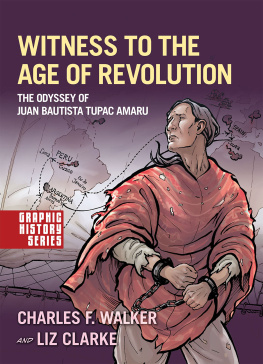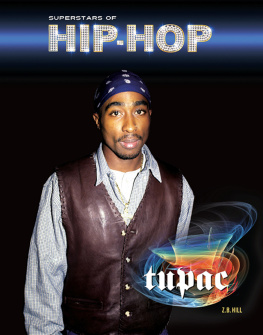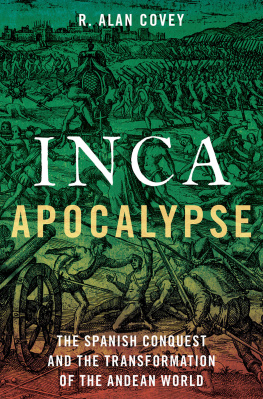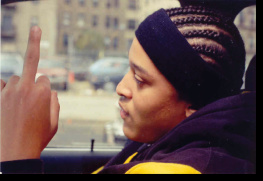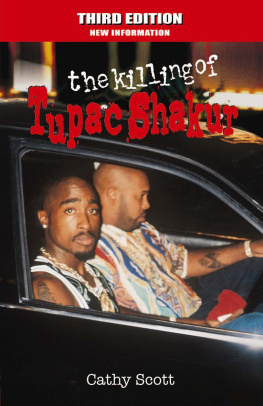The Tupac Amaru Rebellion
THE
TUPAC AMARU REBELLION

Charles F. Walker
T HE B ELKNAP P RESS OF H ARVARD U NIVERSITY P RESS
Cambridge, Massachusetts
London, England
2014
Copyright 2014 by the President and Fellows of Harvard College
All rights reserved
Jacket image: Michael Melford/National Geographic/Getty Images
Jacket design: Graciela Galup
The Library of Congress has cataloged the printed edition as follows:
Walker, Charles F., 1959
The Tupac Amaru rebellion / Charles F. Walker.
pages cm.
Includes bibliographical references and index.
ISBN 978-0-674-05825-5 (alk. paper)
1. PeruHistoryInsurrection of Tupac Amaru, 17801781. 2. Tupac-Amaru, Jos Gabriel, 1781. I. Title.
F3444.W35 2014
985' .033dc23 2013037830
To four wonderful historians, with whom I so very much wish I could share this book:
Alberto Flores Galindo
Friedrich Katz
Enrique Tandeter
Eduardo Mendoza Melndez
It is unlikely that in the history of revolutions, another will appear that is more justified or more unfortunate. Spanish America had become in those times the theater of the most extensive tyranny, but the yoke lay most heavily on the necks of Peruvian Indians.
Gregorio Funes
There is a general belief that the declaration of Perus independence, proclaimed by Gabriel Tupac Amaru, was suffocated by his capture and death in May 1781, in Cuzcos main plaza; this is a historical error that needs to be overturned, and only a few people have scoured the archives, collecting the precise sources and rebuilding the real and true facts.
Modesto Basadre
Contents
Introduction:
Conclusion:
Introduction
O N NOVEMBER 4, 1780, Jos Gabriel Condorcanqui Noguera, who increasingly used the Inca royal name Tupac Amaru, had lunch with Antonio de Arriaga at the house of Carlos Rodrguez, the priest of Yanaoca. If a Hollywood producer had asked central casting for colorful individuals who personified political relations in the colonial Andes, he would have been delighted with this trio. Tupac Amaru was the kuraka or cacique, the ethnic authority in charge of collecting the head tax (tribute was the colonial euphemism) and keeping order in Yanaoca and two other small towns, Pampamarca and Tungasuca, fifty miles southeast of the ancient Inca capital Cuzco. The Incas still loomed large in this area. Quechua-speaking Indians constituted the vast majority of the population, and they venerated their ancestors, defeated by the Spanish in the sixteenth century, and those like Jos Gabriel Tupac Amaru who claimed bloodlines from the Inca royalty. Well-educated and bilingual, the forty-two-year-old Jos Gabriel moved easily between the Spanish and Indian worlds. In fact, this was his role as kuraka.
Arriaga was the corregidor, the Spanish authority who collected taxes, arranged the despised labor draft for the massive Potos mines six hundred miles to the south (today Bolivia), and oversaw regional affairs. Arriaga was a nobleman born in 1740 in the Basque country in northern Spain whose family had strong connections to Spains American empire, as members of the all-important Council of the Indies in Madrid and as merchants. Originally from Panama, Father Rodrguez was Yanaocas parish priest. He, along with another priest, Antonio Lpez de Sosa, had been Tupac Amarus first teachers. Impressed by the young boys intelligence, they had remained close to him. These priests nurturing took hold: Jos Gabriel would remain pious and intellectually curious throughout his life. Thus, as was usually the case, Tupac Amaru the kuraka was indigenous or mestizo, Arriaga the corregidor a Spaniard, and Rodrguez a creole, the term used for people of European descent born in the Americas. These three authorities, kuraka, corregidor, and priest, formed the triumvirate that maintained order throughout the Andes under Spanish rule. Two other priests, Arriagas scribe and assistant, and numerous servants also accompanied them at the meal. Jos Gabriels wife, Micaela Bastidas, did not join them.
Arriaga and Tupac Amaru knew each other well. Arriaga had a web of economic activities and, as tax collector and foremost authority, he enjoyed capital and power and had even lent Tupac Amaru money. Although the two had previously bickered over the labor draft or mita to Potos, they shared an amicable meal that day, celebrating the day of Saint Charles (San Carlos), Father Rodrguez and the King of Spains saint day. After Arriaga enjoyed a short siesta, Tupac Amaru invited him to spend the evening at his house in Tungasuca. Arriaga insisted that he had to be back in Tinta, his home and the largest town in the area, about seven miles from Yanaoca, and began the four-hour journey by foot and horse over several precipitous hills. The imminent arrival of tribute money, the Indian head tax that filled colonial coffers, encouraged him to return.
Tupac Amaru and a few young men accompanied the corregidor for a bit and then feigned that they were returning to Tungasuca. Instead, they rushed ahead to a hiding place on a peak, shocking Arriaga and his entourage when they leapt into their path. Arriaga fled into a canyon, hiding behind an apacheta, an indigenous sanctuary or sacred place made of stones. An Indian, however, spotted him and Tupac Amaru tied him up. They waited several hours until late that evening and then they took their prisoners in chains to Tungasuca. They forced Arriaga, his scribe Felipe Bermdez, and two black slaves into a cell in the basement of Tupac Amarus house.
Tupac Amaru compelled the stunned Arriaga to write letters to his treasurer in Tinta requesting money and arms, with the peculiar pretext that he was planning an expedition against pirates on the coast. Tupac Amaru himself then went to Tinta and used Arriagas key to take seventy-five fusils or light flintlock muskets, a small number of standard muskets, gunpowder, bullets, some militia uniforms, mules, silver, 22,000 pesos of tribute money, gold, and other goods.
When Tupac Amaru placed a painting of the Crowning with Thorns in Arriagas cell and sent father Lpez de Sosa to take confession, Arriaga knew that he was in deep trouble. Flabbergasted by the events and conscious that his life was in danger, Arriaga offered his entire fortune to the Pampamarca parish in exchange for freedom, but to no avail. Lpez de Sosa and three other clerics accompanied the corregidor in his cell on November 9.
On November 9, moving on horseback, Tupac Amaru ordered Europeans, mestizos, and Indians to line up in military columns. He was elegantly dressed: black velvet coat and knee-breeches, a ruffled shirt, a vest, linen, silk stockings, gold buckles at his knees and shoes, and a Spanish beaver hat. His attire often included more indigenous flourishes such as the uncu or tunic and a gold chain with the Inca sun. His hair cascaded down his back. The crowd understood that it was witnessing a momentous event. Indians heard, in their own language, about the abolition of the forced sales of goods and the hated labor and sales taxes, and witnessed the condemnation of the maximum Spanish authority in the region. Mestizos and creoles nervously wondered whether these seemingly welcome changes might lead to turmoil and dangerously independent Indians. Spaniards did not fully understand what they were seeing but feared for their lives.
A town crier led the procession to the gallows, announcing that they were fulfilling the Kings wishes and repeating the pledge that customs houses, alcabalas, and the mita would henceforth be abolished. Tupac Amaru ordered the town crier to speak in Quechua, a language never used in official events or in documents.
Speculation on why Tupac Amaru and Micaela Bastidas had executed Corregidor Arriaga circulated like an Andean thunderstorm through the crowd that fateful November 10 and people have not stopped asking the question since. Then and today, people gave reasons that range from the personal (a grudge) to the macropolitical (the weakening of Spanish rule). The biography of Tupac Amaru is, of course, central to the explanation. He had witnessed the worst forms of Spanish exploitation of indigenous people and found himself increasingly hard pressed to fulfill his duties as intermediary between the Quechua and Spanish world. Jos Gabriels work as a merchant and muleteer took him throughout the Andes, while his legal battles to regain a marquisate (a noble title) had forced him to spend eight months in the viceregal capital of Lima in 1777, where he made important contacts and gained a deeper understanding of Peru. He had the respect of Cuzcos Indians, reasons to loathe the Spanish, and the experience and worldliness to organize an uprising.
Next page

